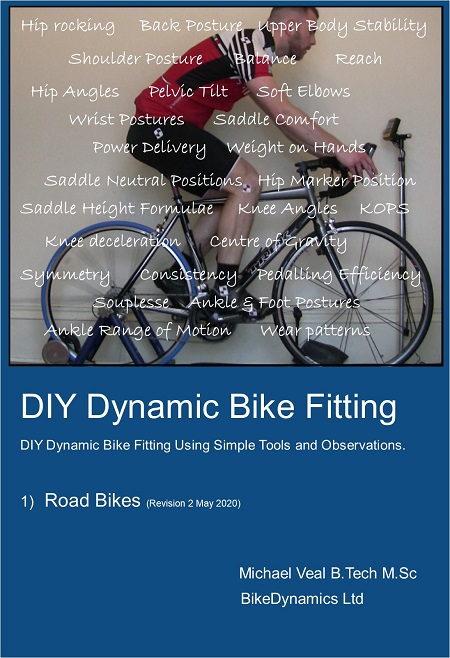Saddle Discomfort
I sometimes think that more research is being applied to saddle design than all other aspects of bike design put together. Different manufacturers advocate their saddle choice processes from Selle Italia's IDMatch Fit to the 'Spine Concept' suggested by Fizik. More recently we have seen saddles with shark fins, stubby noses, no noses, huge central channels and the growing use of pressure mapping to help make that all important purchasing decision. Many of my customers talk of sheds full of saddles, bought, used for a few months then discarded in the pursuit of something better.
Unfortunately, or in many cases fortunately, the principle reason for any saddle discomfort experienced by my customers has often been that the saddle is in the wrong place to begin with. The usual culprit is a high saddle, with the pelvis having to rock across the top of the saddle due to inability of the legs to dynamically extend far enough. A high saddle has a secondary issue of tending to shove you forwards, with your sit bones moving onto a narrower and less supportive section. A low saddle is not necessarily the answer as this can also cause the pelvis to rock as a lack of quad or hip flexibility will lift the pelvis as the foot passes forwards over the top of the stroke.
Other 'Bike Fitting' issues can also cause discomfort from an otherwise blameless saddle. A leg length difference will often cause problems as cyclists will subconsciously balance their leg extensions by moving the hip of the short leg forwards and the long back. This results in a twisted position on the saddle with discomfort often felt on the side of the shorter leg only. A leg length discrepancy coupled with a high saddle and tight hamstrings is a really winning combination that no saddle design can contend with. Cranks that are too long will create an environment where the saddle is effectively both too high and too low at the same time, so is there any wonder the pelvis rocks! An upright torso angle will tend to put more load onto the sit bones, whereas an aggressive riding position will transfer this onto the perineum / crotch. Depending upon the location of the saddle discomfort, changing the torso angle may be the solution.
It would be wrong to suggest that saddles are blameless and all you need to do is put it in the right place. I'm lucky to have found a shape of saddle that works for me, but know from experience that even in a good location, the wrong shaped saddle can destroy all enjoyment of riding a bike. So what should be looking for in saddle design and which parameters are the most important? These are simple enough questions but experience has shown we are all a different shape and choice is very personal. In simple terms, the sit bones (ischial tuberosities) are, as the name implies, designed to be sat upon, so we should try to encourage this. The soft tissue between the sit bones, perineum and genitals were never really intended to support our body weight and as such are full of nerves, blood vessels and 'plumbing' that can be crushed and damaged. Interestingly, having now completed thousands of bikes fittings, only one chap has ever mentioned that cycling has caused him erectile dysfunction. Not really surprising, especially as I don't actually ask them directly (but do interrogate on everything else from toes to fingertips). We may skirt round the issue and talk of 'numbness', most of which is resolved with a few seconds out the saddle and never lasts for more than a few minutes after the ride! My understanding is that the following are the factors we need to consider, in order of importance.
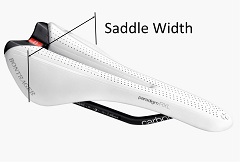
Saddle Width
Most saddle manufacturers are coming round to the idea that width is important. I'm sure somebody will tell me otherwise but I believe Specialized were one of the first manufacturers to actively market different widths and provide ass-meters (sit bone width measuring devices) to stores. Obviously Brooks have been making saddles in different widths for over a century, but still tend to leave it to the customer to decide what size they want. So we could use one of the numerous way to measure sit bone width, then choose an appropriate saddle. Fundamentally this is a sensible approach, but does require some care. The biggest problem is that our sit bones are not single points but 30-40mm long and narrower towards the front. A more upright pelvis may require a wider saddle than one with a strong anterior tilt and how you sit on the ass-meter may affect the measurement. I believe a more sensible approach to define a suitable saddle width is to complement a sit bone measurement with observation of where the cyclist actually sits on a saddle. People with wide sit bones will tend to sit quite far back on narrow saddles. Conversely, a wide saddle will tend to shove you forwards. Using the criteria discussed in Saddle Fore-aft to define a suitable longitudinal position, if the saddle rails are not long enough to get the saddle far enough back, then it is likely that either the saddle is too wide for you (or there could be an inline seat-post fitted). Alternatively, if you don't seem to be able to get the saddle far enough forwards, i.e. you are hanging off the back of it, it is most likely too narrow.
From my measurements most men have around 120mm wide sit bones and women 130-135mm. given how much variability we see in human height, you might expect a similarly wide range in sit bone width, but less than 110mm and greater than is 140mm is quite unusual. We want to rest our sit bones on a nice compliant part of the saddle and not fall off the sides, so saddles will tend to at least 10mm wider each side than the sit bone width, giving typical sizes of 138-144mm, with narrow saddles being closer to 130mm and wide ones of over 150mm.
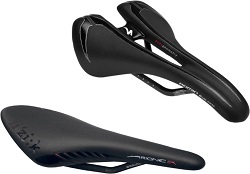
Grooves and Holes.
The presence or not of a grove or hole in a saddle easily comes second on my list of criteria and is a strong contender for first. Using a saddle without some sort of pressure relief through the middle would make me very numb very quickly. A Fizic Arione is typical of the flat 'hole-less' saddle that would cause me problems but many of my customers swear by and get on very well with. The purpose of not having any physical contact between the saddle and the central crotch is entirely concerned with reducing the pressure on the soft tissues in this area, preventing the constriction of blood flows, compression of the urethra etc. The problem with reducing pressures in this area is that the weight has to be supported somewhere, so it will tend to increase under the sit bones. The seams and interfaces around the holes or channels can also be problematical.
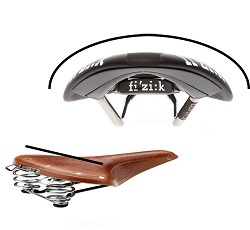
Lateral Curvature
When viewed from the rear, saddles can be relatively flat or quite curved. The stronger the curve the more your weight will be redistributed off the sit bones and onto the crotch. If very flat, pretty much all the pressure will be directly under the sit bones. If not suffering from chaffing due to excessive hip rocking, or asymmetric inner thigh problems, the next major complaint is that the saddle just feels very hard, with every bump amplified. In many cases this will because the saddle is too flat, with high localized pressures either side.
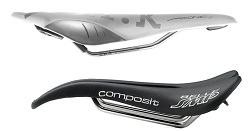
Longitudinal Curve
When viewed from the side, saddles can again be flat or very strongly 'cupped'. At the very least there may be a gentle upward curve of the rear section. It is suggested that flat saddles allow you to move around more easily, coming forwards onto the front when on the drops, or sliding back whilst climbing. Cupped saddles will effectively cradle the pelvis, spreading load and reducing pressures, but possibly impeding any ability to move around.
Padding
Some people think that a soft saddle will be more comfortable, but as a rule, they aren't. In many cases the padding will move around and in the case of gel saddles, pop up somewhere else if squeezed out from under a contact point. There is no doubt that some compliance is desirable, but probably best achieved in the saddle structure itself, the rails and by using cycling shorts.
DIY Dynamic Bike Fitting
You may be interested in our downloadable DIY guide.
49 Page PDF download describing all the observations, simple measurements and calculations required to do your own Dynamic Bike Fits.
Revision 2 released May 2020.
Contains updated male and female saddle height calculators and new information on male / female leg length proportions. Plus a new section to assist with saddle choice and improving comfort.
British Pound, Euro and US Dollar payments are processed by PayPal and all major credit cards are accepted. You will receive an email confirming your payment and will be automatically redirected to a page where you can download the ebook. The ebook is in PDF format so you will need to have a copy of Adobe Acrobat Reader or a similar PDF reader to read the ebook.

